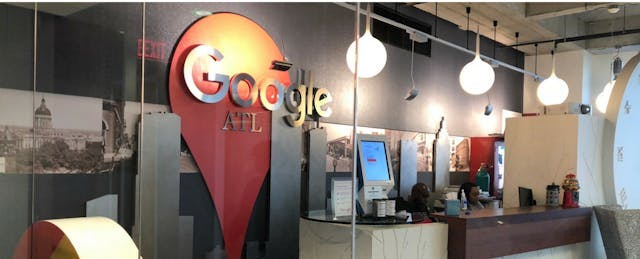ATLANTA—Dr. Caitlin Dooley smiled approvingly as members of the state's leadership team strolled past the bright-red decor splattered throughout Google’s offices in Atlanta. This Monday, the deputy superintendent for the Georgia Department of Education led 30 school leaders through a design thinking workshop hosted by the company. This was the first time that most of them have stepped foot into the Google offices, or heard the term “design thinking.”

Overseeing 181 rural and urban districts, each with vastly different resources and problems, Dooley is aware that creating an innovative ethos throughout all of her state’s public schools will be an uphill battle. The visit to Google, then, was one of her strategies for cultivating an innovative culture in the state.
A tenured research professor at Georgia State University’s College of Education & Human Development, she left that cozy spot two years ago to roll up her sleeves and lead curriculum and instruction at the state department of education. These days, she’s got a host of activities—from broadening the state’s student achievement plans (Every Student Succeeds Act, also known as ESSA), to working on open education resources, to unlocking the creativity and spirit of educators and staff in the state’s department of education. Her touchstone: Can Georgia build an education system that encourages all its students to be self-driven learners?
“When I first came to the Department of Education, I found that a lot of people who worked there had been educators for a long time, but most of them had not been in schools for the last two to three years,” Dooley explained in an interview with EdSurge. “A lot of this [innovation through edtech] is just starting to gain traction, so for the people who are in the state department to know about this—they have to learn. The impetus for this [Google training event] is to give a line of sight for my team.”

Design thinking is often defined as an inquiry-based approach to solving complex problems, encouraging divergent thinking, spontaneity and creativity. Often applied in the business world to inspire the development of new products and strategies, design thinking has become increasingly popular in the education field. IDEO, perhaps the world’s most renowned design-thinking consultancy, has a division dedicated to helping school leaders and reformers.
Erin O’Briant was a former Google employee who ran design-thinking workshops at the company for the last five years. She recently left the tech giant to start her own design thinking consultancy, O’Briant Group, which was by Google hired to support educators build design-thinking skills. In Georgia, Google is organizing design-thinking programs for state education officials and districts.
O’Briant is effusive in championing the power of design thinking. “I was neurologically rearranged,” she told the group at the start of the session. Through a series of exercises, she said the participants would undergo a similar transformation.
O’Briant first laid the ground rules. The Google office was a safe space where educators are encouraged to share even the most seemingly unfeasible ideas. These were called “10X” or “Moonshots,” terms that have become vernacular across the company. (Google staff members involved in New York City’s education programs use similar terminology.)
“In order to get exactly what our user wants, we have to understand them better, so we start with empathy,” O’Briant explained to the group. “What we are going to do in our empathy work this morning is shift our point of view.”
Through a series of games (including good old-fashion rock-paper-scissors to break the ice), videos about brainstorming moonshot ideas, and user-centered design activities and discussions, leaders were spurred to understand themselves, their colleagues and their “end users”—in their case, parents and students. Then they prototyped their final ideas on large notepads.

“I designed this amazing app, now all I need is an angel investor,” explained one educator after the event.
“This is really just an introduction to the idea of design-thinking,” explained O’Briant in an interview with EdSurge. “The work we are doing with Google is about trying to help people find a culture of innovation.”
Beyond this workshop, the O’Briant Group and Google work more closely with districts to build innovative cultures. After spending a day at Google to reflect on each district’s culture, the firm then shares with district leaders and teachers some of Google’s innovation strategies, such as 20 percent time (where full-time Google employees can devote 20 percent of their time to doing whatever passion project they want). Then they offer districts design-thinking labs, where groups are tasked with identifying problems they want to solve or spaces they want to redesign. The hope is that after administrators have received training, they will continue implementing innovative strategies that shift the school culture.
“I hope the design-thinking experience helps us to develop a new mindset about how we approach problems and challenges. When you are in the classroom, you always have to think about problems and challenges and how to solve them creatively,” noted O’Briant.
Dooley’s desire to change the culture in Georgia will require more than one day of design-thinking. Outside of the workshop, her team has included concepts such as educating the whole child, a continuous improvement model and teaching “beyond the core” into the state’s draft ESSA plan.
“We are shifting from an evaluative framework to one of service and support,” said Dooley.
According to Georgia’s ESSA plan, educating beyond the core measures how many students in a district are passing courses in subjects other than reading and math--namely, areas such as fine arts, world languages, physical education/health and career exploratory classes. The emphasis on the whole child is meant to encourage school districts to go beyond tightly focusing on test scores as a measure of success. The continuous improvement model is meant to nudge districts (even those with high tests scores) to constantly innovate and improve. Dooley hopes that these written concepts in conjunction with workshops, and other professional development activities will help steer continuous innovation in the state education system.
“We are all learners together we are trying to innovate and collaborate as we support learners,” Dooley explained to the group. “We are of the mindset that all schools need to improve, not because schools are horrible but because society is changing.”


